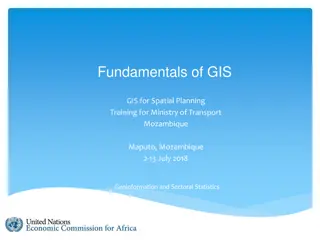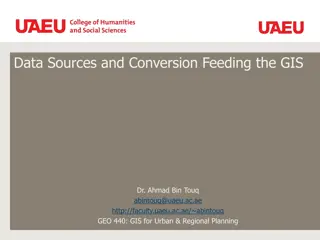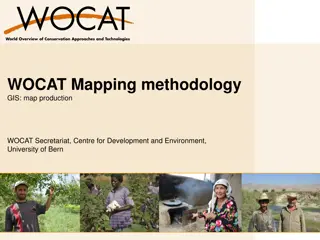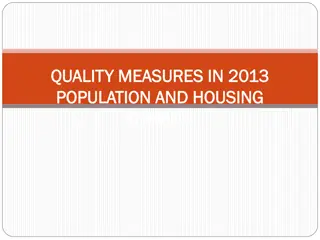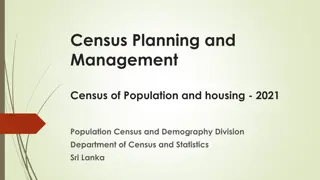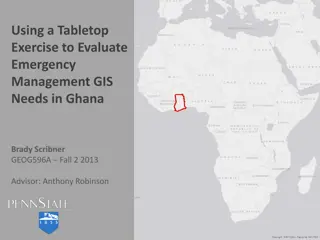Importance of Maps and GIS in Census Mapping: A Case Study from Nepal
Census mapping plays a crucial role in ensuring accurate population counts and territorial delineation. This case study from Nepal highlights the significance of Geographic Information Systems (GIS) in producing high-quality maps for census operations, data collection, analysis, and dissemination. The development of census mapping, particularly in Nepal, has evolved over the years to improve the accuracy and reliability of census results by utilizing digital mapping technologies and detailed enumeration area delineation.
Download Presentation

Please find below an Image/Link to download the presentation.
The content on the website is provided AS IS for your information and personal use only. It may not be sold, licensed, or shared on other websites without obtaining consent from the author.If you encounter any issues during the download, it is possible that the publisher has removed the file from their server.
You are allowed to download the files provided on this website for personal or commercial use, subject to the condition that they are used lawfully. All files are the property of their respective owners.
The content on the website is provided AS IS for your information and personal use only. It may not be sold, licensed, or shared on other websites without obtaining consent from the author.
E N D
Presentation Transcript
Census Mapping in Nepal Mahesh Kumar Subedi & Prakash Poudyal Central Bureau of Statistics (CBS) Kathmandu, Nepal United Nations Regional Workshop on the 2020 World Programme on Population and Housing Censuses: International Standards and Contemporary Technologies, 8 11 May 2018, Colombo, Sri Lanka
Introduction Without well defined territory, possibility of double counting or missing of the population is possible. Well-defined EA maps using GIS application are crucial in defining exact territorial boundaries in census taking. The quality of Maps used in the censuses has a major impact on the quality and reliability of census results. GIS has important role in census operation as well as the dissemination and analysis of census results
The Role of Maps in the Census Maps are essential in all stages of a census or survey i.e. in planning, data collection, and analysis and dissemination/presentation of the result. The role of maps in the census is very important particularly in enumeration work and presenting census results. This role has been expanded with the introduction of digital mapping system. GIS has played a key role in production of EA maps as well as thematic mapping of census data.
The Role of Maps in the Census The census mapping task can be divided into three major components: pre-census, census-enumeration, and post-census mapping operation.
Development of Census Mapping in Nepal An important pre-requisite to the census coverage is the proper and complete delineation and identification of enumeration areas (EAs). This will require high quality cartographic work. Nepal has been undertaking decennial population censuses since 1911. However, the previous censuses before 1991 were conducted without detailed maps, with properly delineated boundaries of the census units such as census sub-units of the districts, villages and wards/blocks. The firth cartographic works undertaken for the 1991 census was limited in scope and had many shortcomings like the maps prepared for the census operation were based on small scale (1:25,000) and limited filed work. Therefore, the pre-census mapping is the most basic concerns for significant improvement of census taking in Nepal.
Population Census 1991 The topographical maps developed by Department of Survey were used in 1991 Census. The maps up to the Village Development Committee levels (administrative units) were prepared for conducting the census. The map did not have ward (the lowest administrative unit) delineation and contained some detail information like settlements names, rivers, roads.
Population Census 2001 Population census mapping project was started in 1998 and prepared base maps. This project also had prepared the maps up to the Village Development committee (VDC) and municipality level with ward boundary delineation. Khopi VDC, Mahottari District The existing topographic maps (1992-2002) were digitized in order to create digital database, which were used to produce EA maps for census. Banarjhula VDC, Saptari
Population Census 2011 Population census mapping project for 2011 was funded by Danish Government. Preparation of the EA maps began in 2009, two years before the census year, by the GIS of the CBS. The Orthophoto, a database of digital maps provided by the Department of Survey, was used to prepare VDC maps with ward boundaries. The wards or sub-wards are considered as EAs with households ranging from 200 to 450. The scale of EA maps varied from 1:10,000 to 1:20,000; This project prepared EA maps for nearly 50 municipalities and maps for all VDCs showing ward boundary. Using GIS, Population Atlas 2014 was prepared based on population census 2011 data.
Biratnagar WN 10 Biratnagar WN 10
Short comings and challenges in 2011 Census mapping Due to limited time and resources, not all VDC maps were updated with changed features. Only municipalities and large VDCs with urban characteristics were selected and updated with amended features and ward boundaries. There were rapid changes in municipalities (urban areas) from the time the maps were prepared until the time that fieldwork took place which could not be included. Census staff in rapidly changing urban centres had difficulty in tracing newly developed parts. The GIS section has shortage of skill, equipment and man power for a complete mapping work in 2011.
Further plan to 2021 census Strengthening the GIS unit of CBS with new technologies and human resources. Timely starting of census mapping work at least 3 years before the field work of 2021 census. Preparation of EA maps as per the new set up of the country - now the country has divided into 7 provinces and 753 local units. A plan for a continuous updating of EA maps until the last moment, especially in rapidly developing urban areas in order to reduce coverage errors.











